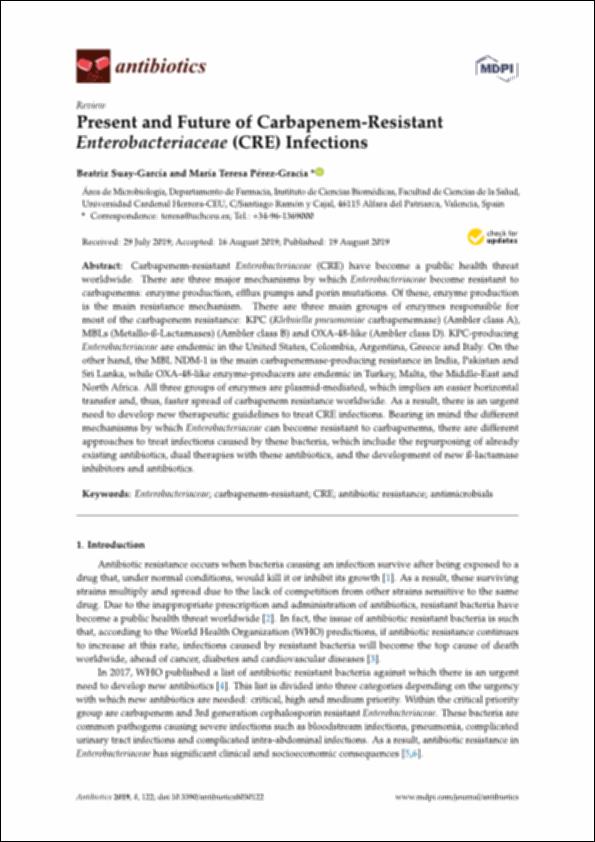Please use this identifier to cite or link to this item:
http://hdl.handle.net/10637/10748Present and future of Carbapenem-Resistant Enterobacteriaceae (CRE) infections
| Title: | Present and future of Carbapenem-Resistant Enterobacteriaceae (CRE) infections |
| Authors : | Suay García, Beatriz Pérez Gracia, María Teresa. |
| Keywords: | Antibióticos.; Antibiotics.; Drug resistance in Enterobacter.; Enfermedades infecciosas - Tratamiento.; Enterobacterias - Resistencia a los medicamentos.; Communicable diseases - Treatment. |
| Publisher: | MDPI |
| Citation: | Suay-García, B. & Pérez-Gracia, MT. (2019). Present and future of Carbapenem-Resistant Enterobacteriaceae (CRE) infections. Antibiotics, vol. 8, n. 3 (ag.), art. 122. DOI: https://doi.org/10.3390/antibiotics8030122 |
| Abstract: | Carbapenem-resistant Enterobacteriaceae (CRE) have become a public health threat worldwide. There are three major mechanisms by which Enterobacteriaceae become resistant to carbapenems: enzyme production, e ux pumps and porin mutations. Of these, enzyme production is the main resistance mechanism. There are three main groups of enzymes responsible for most of the carbapenem resistance: KPC (Klebsiella pneumoniae carbapenemase) (Ambler class A), MBLs (Metallo-ß-Lactamases) (Ambler class B) and OXA-48-like (Ambler class D). KPC-producing Enterobacteriaceae are endemic in the United States, Colombia, Argentina, Greece and Italy. On the other hand, the MBL NDM-1 is the main carbapenemase-producing resistance in India, Pakistan and Sri Lanka, while OXA-48-like enzyme-producers are endemic in Turkey, Malta, the Middle-East and North Africa. All three groups of enzymes are plasmid-mediated, which implies an easier horizontal transfer and, thus, faster spread of carbapenem resistance worldwide. As a result, there is an urgent need to develop new therapeutic guidelines to treat CRE infections. Bearing in mind the di erent mechanisms by which Enterobacteriaceae can become resistant to carbapenems, there are di erent approaches to treat infections caused by these bacteria, which include the repurposing of already existing antibiotics, dual therapies with these antibiotics, and the development of new ß-lactamase inhibitors and antibiotics. |
| Description: | Este artículo se ha publicado de forma definitiva en: https://www.mdpi.com/2079-6382/8/3/122 |
| URI: | http://hdl.handle.net/10637/10748 |
| Rights : | http://creativecommons.org/licenses/by/4.0/deed.es |
| ISSN: | 2079-6382 (Electrónico) |
| Issue Date: | 14-Aug-2019 |
| Center : | Universidad Cardenal Herrera-CEU |
| Appears in Collections: | Dpto. Farmacia |
Items in DSpace are protected by copyright, with all rights reserved, unless otherwise indicated.


